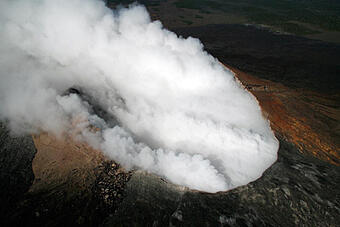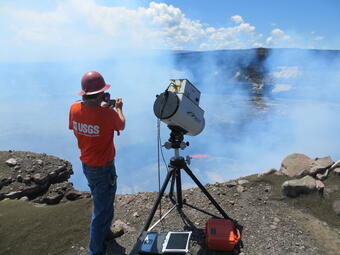Frequently Asked Questions about volcanic gas at Kīlauea

1. What gases are emitted by Kīlauea and other active volcanoes?
Ninety-nine percent of the gas molecules emitted during a volcanic eruption are water vapor (H2O), carbon dioxide (CO2), and sulfur dioxide (SO2). The remaining one percent is comprised of small amounts of hydrogen sulfide, carbon monoxide, hydrogen chloride, hydrogen fluoride, and other minor gas species.

2. Who monitors volcanic gases emitted by Kīlauea?
The U.S. Geological Survey's Hawaiian Volcano Observatory (HVO) determines the amount and composition of gases emitted by Kīlauea Volcano (read Monitoring Volcanic Gas at Hawaiian Volcanoes to learn more). Changes in gas emissions can reveal clues about the inner workings of a volcano, so they are measured on a regular basis.
HVO scientists share scientific data and work closely with other government agencies responsible for making decisions regarding public safety, including Hawai‘i County Civil Defense, Hawai‘i State Department of Health, and Hawai‘i Volcanoes National Park.

3. How do HVO scientists measure volcanic gas emissions at Kīlauea?
USGS HVO uses both remote and direct sampling techniques to measure the composition and emission rate of gas from Kīlauea Volcano. Gas emissions are measured "campaign style," that is, scientists go to the field to collect the data, as well as continuously by stationary instruments.
To determine how much sulfur dioxide (SO2) is emitted, HVO scientists measure the amount of ultraviolet (UV) radiant energy absorbed by the volcanic gas plume as sunlight passes through it. One way they do this is by attaching a miniature-UV spectrometer to a vehicle and driving the upward-looking instrument beneath the plume. Using these data, scientists can compute the SO2 emission rate, typically reported in units of metric tons per day (one metric ton equals 2,200 pounds) or kilograms per second.
Also at the summit of Kīlauea, a stationary array of 10 upward-looking UV spectrometers known as FLYSPECs automatically measures SO2 emission rates as the plume travels overhead.
During steady trade winds, the FLYSPEC systems measure SO2 every 10 seconds and send data to HVO via radio. In the absence of trade winds, SO2 emission rate measurements are more challenging to acquire. Generally, steady trade winds and little or no rain result in the highest quality data.
HVO also uses an ultraviolet camera to image the plume and provide emission rate information.
Both the FLYSPEC and ultraviolet camera techniques require moderate emission rates of SO2 to provide useful information; for low emission rates, HVO relies on the vehicle-based emission rate measurements.
In addition to emission rates of SO2, HVO also measures ambient concentrations of volcanic gases at Kīlauea. Three stations near the summit report SO2 concentrations every ten minutes. Another station, called a MultiGAS, at the summit reports concentrations of SO2, CO2, H2S, and water vapor eight times per day. We also have portable MultiGAS sensors that can be carried or mounted on a UAS (unoccupied aircraft system) to determine concentrations of those same four gases in various places.
Another tool used to measure the relative abundance of different gases, including SO2, CO2, hydrogen chloride (HCl), hydrogen fluoride (HF), carbon monoxide (CO) and water vapor (H2O), is the Fourier Transform infrared spectrometer (FTIR). The FTIR measures the amount of energy absorbed by gases along the path between the spectrometer and an infrared source, such as incandescent lava or a lamp.
We can also collect gas directly into a specialized glass bottle or metal tube. By collecting direct samples, we get a fuller picture of all gas species that Kīlauea is emitting by obtaining chemical analysis of the gas samples. HVO collects direct samples at least four times per year at Sulphur Banks, near Kīlauea’s summit in Hawai‘i Volcanoes National Park.
- Monitoring Volcanic Gas at Hawaiian Volcanoes
- Monitoring Volcanic Gases
- Impacts of Volcanic Gases on Climate, the Environment, and People
4. How much sulfur dioxide (SO2) gas comes from Kīlauea?
Kīlauea has previously emitted between 500 and 10,000 metric tons of sulfur dioxide gas (SO2) each day (t/d) during periods of continuous eruption, like that between 1983 and early 2018. Regular emission rate measurements began at Kīlauea in 1979, when a few hundred tons of SO2 were released each day from the summit area. The onset of the East Rift Zone (ERZ) eruption at Pu‘u‘ō‘ō in 1983 was accompanied by a large increase in SO2 release: emissions averaged about 1500-2000 t/d during the first decades of the ERZ activity. Another large increase in emissions occurred in 2008 when the summit lava lake eruption began. While Pu‘u‘ō‘ō was the main source of gas release from 1979–2007, from 2008 to early 2018, Kīlauea Volcano's summit vent in Halema‘uma‘u Crater was the dominant gas source. Prior to 2018, Kīlauea emitted more than five times as much SO2 as the top emitting power plant in the United States, but less than 1 percent of global SO2 generated by humans. During Kīlauea’s eruption in 2018, emission rates at the Kīlauea summit increased briefly during the explosive activity in May, but then decreased steadily. In the lower East Rift Zone, measured emission rates were the highest measured at Kīlauea, over 100,000 t/d for much of the three months of the 2018 fissure eruption. Following the end of the 2018 eruption, emission rates in the lower East Rift Zone, at Pu‘u‘ō‘ō, and at the summit decreased drastically. By the end of 2018, Kīlauea was emitting only about 50 t/d of SO2. SO2 emissions remained below 50 t/d until a summit eruption began on December 20, 2020. At the onset of the new eruption in December 2020, Kīlauea summit emission rates were 30,000–40,000 t/d. SO2 emissions progressively dropped to around 2,500 t/d on January 11, 2021, telling us that the eruption rate decreased. SO2 emissions have recently varied between 300-1200 t/d.
- Sulfur Dioxide Emission Rates of Kīlauea Volcano, Hawai'i, 1979-1997
- Sulfur Dioxide Emission Rates from Kīlauea Volcano, Hawai'i, an Update: 1998-2001
- Sulfur Dioxide Emission Rates from Kīlauea Volcano, Hawai'i, an Update: 2002-2006
- Sulfur Dioxide Emission Rates from Kīlauea Volcano, Hawai‘i, 2007-2010
- Sulfur Dioxide Emission Rates from Kīlauea Volcano, Hawaiʻi, 2008-2013
- Measuring SO2 Emission Rates at Kīlauea Volcano, Hawaii, Using an Array of Upward-Looking UV Spectrometers, 2014–2017
- New assessment of Kīlauea's extreme SO2 emission rates in 2018
- Quantifying gas emissions associated with the 2018 rift eruption of Kīlauea Volcano using ground-based DOAS measurements

5. Why do I still smell sulfur when SO2 emissions are low?
SO2 is emitted primarily when lava is on the surface or if magma is very shallow and close to the surface (within 100s of meters or yards). With no lava presently erupting from anywhere on Kīlauea, SO2 emissions are very low. Since the end of the 2018 eruption, car-based measurements using an ultraviolet spectrometer on nearby roads show that SO2 emissions are less than 50 t/d at the summit, less than 100 t/d at Pu‘u ‘Ō‘ō, and below detection limits (<~20 t/d) in the lower East Rift Zone. Thus, total Kīlauea SO2 emissions are less than a few hundred t/d of SO2. The significant decrease in SO2 emissions has resulted in drastically reduced vog downwind of Kīlauea. SO2 emissions are decreased, but some SO2 is still present. Additionally, the cooler and wetter volcanic conditions mean H2S is also present. Both gases smell ‘like sulfur’, but while SO2 is a ‘sharper’ smell (like a struck match), H2S smells like rotten eggs. Human noses are very sensitive to H2S, so even with the current low emission rates, minor amounts are noteable.
6. Will Kīlauea emit high levels of SO2 again?
Kīlauea is one of the best-studied volcanoes on Earth, but much about the volcano's behavior remains unknown. To forecast future behavior of active volcanoes, scientists often look to the past. The first written accounts of Halema‘uma‘u were recorded by William Ellis when he trekked to Kīlauea's summit in 1823. Since then, Halema‘uma‘u eruptions have ranged in duration from over a century to less than day. Kīlauea could erupt again, but we don't yet know when or where.

